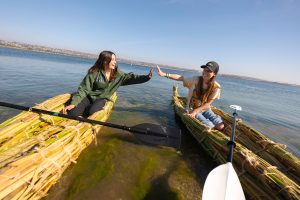
At the 20th anniversary of Love Your Wetlands Day on Feb. 1, participants engaged in conservation activities, heard science talks and helped repair and build traditional Native American tule boats while exploring Mission Bay’s Kendall-Frost Marsh Reserve.
The day-long celebration was dedicated to education about the vital importance of wetlands and their role in the ecosystem. It was also a once-a-year opportunity to explore the marsh, which is the last remaining 1% of wetlands left in Mission Bay.
Kendall-Frost is a 20-acre University of California Natural Reserve System reserve on the northern shore of Mission Bay. Administered by UC San Diego, the site is owned by the University of California and managed for teaching and research.

Love Your Wetlands marked the first time many have seen UCSD’s Community Learning Center and Field Station there, which aims to make the reserve more publicly accessible. The relatively new facility represents a major step forward in the university’s commitment to environmental research, education, and community engagement.
The field station includes two bedrooms for researchers conducting multi-day, overnight research projects and community teaching spaces to engage with community members, school groups, and university classes. The space also provides opportunities for nonprofit and educational groups to host presentations.
Speaking of the celebratory event’s significance and origin, Andrew Meyer, director of conservation for the San Diego Bird Alliance said: “This is City property where this event happens. It started 20 years ago. It was (originally) about the northeast corner of the bay, a little bit of the City’s work, and a little bit of UCSD’s work. They started it as a community event. In 2019, we started partnering with them.”
Meyer talked about ongoing efforts to rehabilitate and expand the marsh reserve. “The City’s De Anza Plan includes a nature center,” Meyer said adding, “There is no place (currently) that introduces you to all of the reasons why Mission Bay Park is here. Groups like ours would love a space, a building, that could host programs, could be a classroom, a laboratory for Mission Bay High School, and could be a kiosk component. That whole perspective is missing from the marsh, and needs to be in here (explaining) how we invite and interact with the public.”
How will environmentalists re-establish more wetlands marshes in the future? “The City last May passed their land-use plan for the northeast corner of the bay,” noted Meyer. “It was pretty good, 83% of the acres we were going for. We want them (City) to improve it, and then we want them to get it done. Now the City, community partners, and funders have to get on board to help make that happen. It’s going to be expensive, and it’s going to take some time to move those puzzle pieces around.”

Credit to “Erik Jepsen, UC San Diego”
Debra D. Bass, director of communications for the Office of Research and Innovation at UC San Diego, shared that the event drew “nearly1,300 attendees this year, an all-time high. This year, we also recorded 112 volunteers who collected 75 pounds of trash from around the wetland edge and in the wetland. Nearly 10% of items, by volume, collected were recyclable CRV items; 44% were plastics including small toys, balls, wrappers, and containers for household products and food; and the rest included metal and wood debris, and cardboard.”
Theresa Talley and Tanya Torres from California Sea Grant at UC San Diego’s Scripps Institution of Oceanography sorted the trash. Marsh walks to collect trash were organized by Sierra Vasquez, a Roy Little Fellow with UC San Diego’s Natural Reserve System. Vasquez is a UC San Diego senior majoring in biology (ecology, behavior, and evolution).
“Our work emphasizes the science behind wetlands and their incredible benefits to communities, from improving water quality to enhancing economic opportunities,” said Kellie Uyeda, the UC San Diego Natural Reserve System executive director. “This event not only honors two decades of wetland conservation. but also serves as a platform for community engagement in habitat restoration.”
“Love Your Wetlands Day is a beautiful testament to the power of community and science coming together to protect and restore wetlands,” said Cristina Santa Maria, Bird Alliance conservation manager. “Every year, we witness the growing impact of dedicated individuals – from children to seasoned environmentalists – who share our mission of defending our region’s vital habitats for birds, other wildlife, and future generations. Together, we’re making sure they (wetlands) stay healthy and vibrant for years to come.”
HISTORY OF KENDALL-FROST MARSH
In 1952, Lena Kendall and the A. H. Frost estate donated two parcels of the upper marsh to the University of California. In 1965, the site became one of the first seven reserves in what is now known as the University of California Natural Reserve System. The reserve ranges from high marsh to submerged shoreline and includes coastal salt marsh, mudflats, tidal channels, and salt flats. Subtidal habitats featuring eelgrass beds shelter juvenile fish and invertebrates. Algae and bacterial mats coating mudflats exposed by high tide feed shorebirds and other species. The marsh is used by students and scientists to study salt marsh ecology and practice field research techniques. Restoration efforts, such as a project to rid the marsh of invasive mangroves, have helped to improve the functioning of the habitat and improve conditions for native species.







Discussion about this post